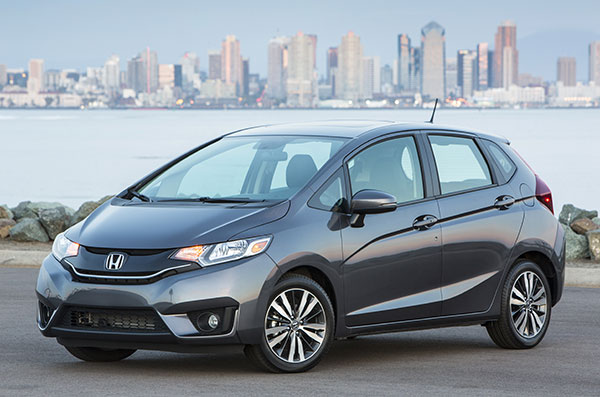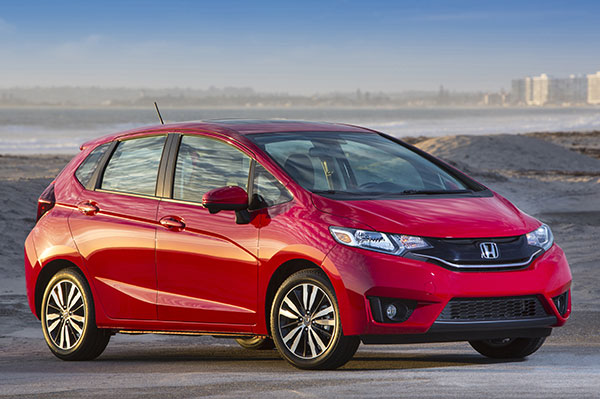

an account. You can:
Access your saved cars on any device.
Receive Price Alert emails when price changes,
new offers become available or a vehicle is sold.


Model Overview of The Honda FIt's For Sale in Middletown, CT
2016 Honda Fit Information
2016 Honda Fit
The Honda Fit is already a small icon, in the second year of its third generation. Its redesign for 2015 stole much of the originality of the styling, and some of the cars character, while gaining cabin room in the small footprint. The latest Fit is not as much fun to toss around, and its continuously variable transmission is sometimes a drag, but it theres more horsepower, torque, and miles per gallon.
The wheelbase is 1.2 inches longer while the length is 1.6 inches shorter. But this efficient package has lost cargo capacity, from 57.3 to 52.7 cubic feet, possibly from the rear seat being pushed back to gain legroom from 34.5 to 39.3 inches.
The Honda Fit is a winner in flexibility, fuel mileage and safety for small five-door hatchbacks, among them the Chevrolet Sonic, Hyundai Accent, Nissan Versa and Toyota Yaris.
The Fit uses a 1.5-liter engine with direct injection that makes 130 horsepower and 114 pound-feet of torque. A sweet 6-speed manual gearbox is standard, replacing the former 5-speed, but most Fits will have the CVT that can (and often needs to be) shifted manually, using paddles that trigger seven speeds.
With the CVT, the Fit is EPA-rated at 33/41 mpg City/Highway mpg. In 430 miles, about 360 of them at 74 mph, our Fit averaged 34.9 mpg.
The 2016 Fit gets 5 stars overall from the National Highway Traffic Safety Administration, and was named a Top Safety Pick by the Insurance Institute for Highway Safety.
2015 Honda Fit Information
2015 Honda Fit
If theres one single area where Honda shows the rest of the industry how it should be done, its packaging, and the Fit is Hondas packaging poster child. Introduced for the 2001 model year, the Fit is regularly compared to the tents from the Harry Potter movies, tiny on the outside, impossibly roomy within.
The 2015 Honda Fit is nominally the third generation, but really the first total makeover of Hondas smallest U.S. vehicle. And as makeovers go, this goes further than most: new unibody, new interior, new engine, new transmissions, new styling, safety upgrades, improved fuel economy ratings. Essentially there is no carry over from the previous Fit.
Like previous generations, and like its entire competitive class, the latest Fit is a front-drive subcompact. Unlike some competitors, its offered only as a five-door hatchback.
The 2015 Fit wheelbase has been stretched, from the previous 98.4 to the current 99.6 inches, but overall length has actually diminished, from 161.6 to 160 inches. Width expands slightly, from 66.7 to 67 inches, and height is unchanged at 60 inches. While there has been some reapportioning of interior volume, the overall impression is unchanged: how did they pack this much space into such diminutive exterior dimensions? Particularly in the rear seat area. Once again, Honda seems to be defying physical laws.
Structurally, the new car benefits from expanded use of high-strength steel, reducing chassis weight and increasing its rigidity. Torsional rigidity is up by 15 percent, according to Honda, and shows to advantage in the Fits eager handling traits.
Overall, the new car has gained a bit at the scales, less than 20 pounds when comparing base model to base model, a little more in others. This is due largely to added standard feature content and noise reduction measures. But the slight weight gain, which varies depending on trim level, is offset by a substantial increase in engine output.
The displacement of the Fits four-cylinder engine is unchanged at 1.5 liters, but this is a new DOHC 1.5-liter, with Hondas iVTEC variable valve timing and lift system, direct fuel injection, more power, and improved fuel economy numbers. The Fits previous 1.5 was a single overhead cam design with port injection, rated 117 horsepower at 6600 rpm and 106 pound-feet of torque at 4800, and was EPA rated for 27/33 mpg City/Highway when paired with the then-standard 5-speed manual transmission.
The new engine produces 130 hp at 6600 rpm, 114 lb-ft at 4600, and is EPA rated for 29/37 mpg paired with the new 6-speed manual. A continuously variable transmission (CVT) replaces the previous 5-speed automatic, and is the only automatic option offered with the new car. In most trim levels the CVT-equipped Fit is rated 32/38 mpg, though in the basic LX it cracks the magic 40-mpg frontier at 33/41.
Like many contemporary CVTs, the Fits new automatic is programmed for simulated steps controlled by paddles shifters, to mimic the up- and downshifts of a conventional automatic. This mitigates the occasional slipping clutch effect that still plagues CVTs, but the new manual gearbox is distinctly more entertaining to employ.
Previous Fits have never been much of a threat in auto beauty contests, but the latest edition looks a little less utilitarian and a little more like a small scale street fighter.
Then theres that amazingly spacious interior. The change will be instantly apparent to anyone who climbs into the back seat, where the design team has exploited the wheelbase stretch to increase rear seat legroom by a mind-boggling 4.8 inches. Previous Fits stood out for exceptionally voluminous rear seat space, as measured against other subcompacts and compacts. With 39.3 inches of rear legroom, the new Fit is roomier than a good many mid-size sedans.
The Honda Fit had some catching up to do in terms of safety ratings, and this appears to have taken place. An early-production 2015 Honda Fit was originally tested in March 2014 by the Insurance Institute for Highway Safety and earned a Good rating in four out of five IIHS crash test modes but a Marginal score in the challenging small overlap frontal crash test. Honda made a running change to the bumper structure, the Fit was re-tested and earned an Acceptable score in the small overlap frontal crash test, which earned a top rating of Good from the IIHS. Early-production 2015 Fit models without the change can be retrofitted with the update. Honda says no vehicle in its class has received a higher rating from the IIHS than the Fit, which has been named a Top Safety Pick by the insurance industry organization.
2013 Honda Fit Information
2013 Honda Fit
The Honda Fit is practical, economical, and roomy. It's also the most enjoyable to drive of the subcompacts.
New for 2013 the Fit EV electric vehicle joins the lineup. Otherwise, the Fit carries into the 2013 model year unchanged. The current-generation Fit was launched as a 2009 model, and the styling was revised for 2012.
Honda Fit's 1.5-liter engine is smooth and powerful, impressive for an engine that small. It's rated at 117 horsepower at a high-revving 6600 rpm, with 106 foot-pounds of torque at 4800 rpm. Yet there's always sufficient torque, that force that propels you from intersections and up hills.
Mated to a 5-speed automatic transmission with paddle shifters, it's an exceptional powertrain. The Honda automatic has a Sport mode that holds the transmission in gears longer when you're in Drive, and not using the paddles for manual shifting. This Sport mode is meant for sports car-like driving, which the Fit likes. The 5-speed manual gearbox, meanwhile, is tight and fun, with a clutch that's easy to use. We recommend it for driving enthusiasts. All models come with Vehicle Stability Assist (VSA).
Fuel mileage for the 2013 Honda Fit is EPA-rated at 28/35 mpg City/Highway with the 5-speed automatic, or 27/33 mpg with the 5-speed manual.
Underway, the Honda Fit feels like a bigger car, partly because the dashboard is long, to accommodate the raked windshield, and partly because there's so much legroom in the front, again thanks to that rake. Thanks to the expansive greenhouse and big mirrors, there's excellent visibility in all directions, including out the vertical and unobstructed rear glass.
With its wedge-shaped front end, the Fit has a presence that reaches beyond its subcompact status. Its size is just right for many drivers. It's easy to park and maneuver and inside is an amazingly configurable interior, helped by what Honda calls the Magic Seat. The second row of seats can be folded and flattened for carrying cargo, and the front passenger seat slides way forward and reclines way back, creating a long space from dashboard to liftgate that can hold a kayak.
The black cloth seats are wonderful, upholstered in a smooth comfortable material that's pleasing to the touch, and the bolstering is just right, with excellent cornering support. In fact, the seats would work in a sports car. Lots of cubbies and cupholders make everyday driving convenient. Rear legroom is roomier than that of the Toyota Yaris, Mazda2, and Ford Fiesta.
The Fit is relatively expensive among subcompacts. It's the best driver's car among these, so if you're a driving enthusiast, the Fit is the best choice. However, if purchase price is more important, then you should compare prices, features and equipment with the Mazda2, Ford Fiesta and Nissan Versa.
New to the Fit lineup for 2013 is the all-electric Fit EV. We found the 2013 Fit EV fizzy, fun and fast. But it's not available in most of the country. In fact, even in California and Oregon, the only states where the car is being marketed to date, it can only be leased, at a price of $389 per month over a three-year term, which computes to a Manufacturer's Suggested Retail Price (MSRP) of $36,625. Honda plans to lease only about 1,100 pearl-blue EVs through 2014, so you may not even be able to get one, although that could change. Availability will expand to the East Coast in early 2013, the company says.



